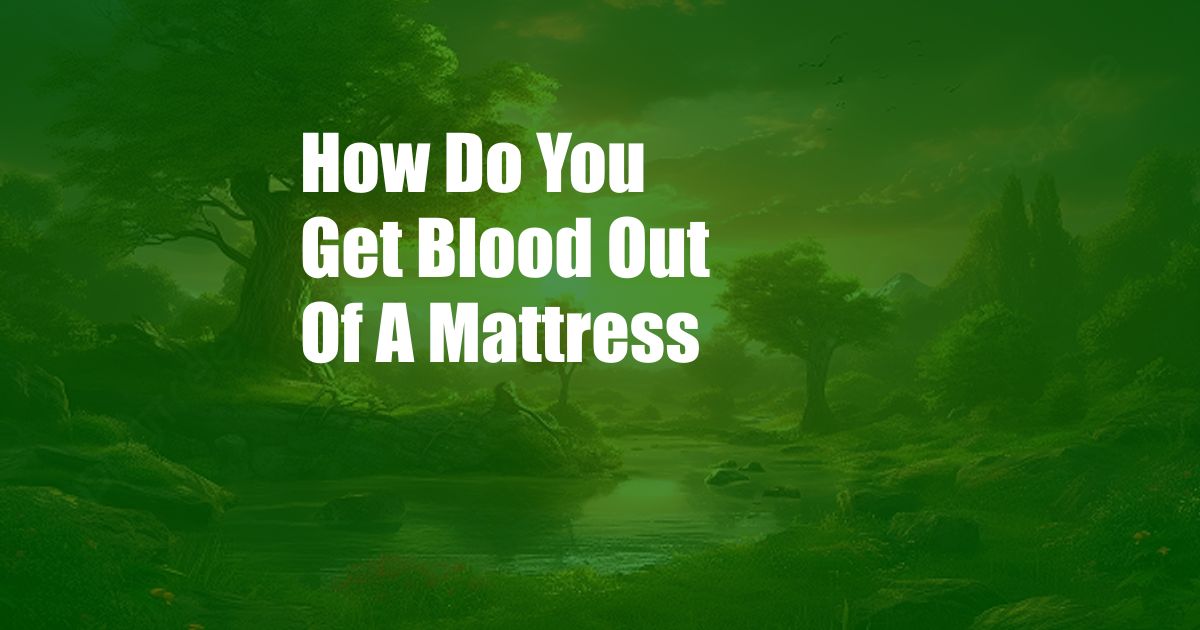
Blood on the Mattress: A Guide to Restoration
Introduction: Have you ever found yourself in a situation where you spilled blood on your mattress? It can be frustrating and daunting, but don’t fret. In this comprehensive guide, we’ll delve into the intricacies of mattress blood removal, empowering you with the knowledge and techniques to restore your mattress to its pristine condition.
Spills and accidents are an unfortunate reality, especially when it comes to mattresses. Whether it’s a nosebleed, a cut, or a menstrual leak, getting blood out of a mattress requires prompt action and the right approach. Neglecting the stain can lead to permanent discoloration, odor, and even bacterial growth, compromising both the aesthetics and hygiene of your sleeping sanctuary.
Identifying the Severity of the Stain
Fresh Stain: If the blood stain is fresh, you have a higher chance of removing it successfully. Act quickly to prevent the blood from setting deep into the mattress fibers.
Dried Stain: Dried blood stains are more challenging to remove. The longer the stain remains, the more likely it is to become embedded in the fabric. However, with patience and the right techniques, it’s still possible to restore your mattress.
Materials Required:
- Clean cloths or paper towels
- Cold water
- Hydrogen peroxide (3% solution)
- Dish soap
- Baking soda
- Vacuum cleaner
Step-by-Step Guide to Removing Blood Stains:
1. Blot and Rinse:
Using a clean cloth or paper towels, blot the blood stain gently to absorb as much excess liquid as possible. Avoid rubbing, as this can spread the stain.
Rinse the area with cold water. Use a spray bottle or a damp cloth to saturate the stain and help loosen the blood. Do not use hot water, as it can set the stain.
2. Hydrogen Peroxide Treatment:
Apply a small amount of 3% hydrogen peroxide to the stain using a cotton ball or clean cloth. Allow it to sit for 10-15 minutes, as it helps break down the blood proteins.
Blot away the hydrogen peroxide and rinse the area again with cold water. Repeat this process if necessary.
3. Dish Soap Solution:
Mix a few drops of dish soap with cold water to create a cleaning solution. Using a clean cloth, gently scrub the stain with the solution in a circular motion.
Rinse the area thoroughly with cold water to remove any residual soap.
4. Baking Soda Absorption:
Sprinkle a generous amount of baking soda over the damp stain. Let it sit for several hours, or even overnight, to absorb any remaining moisture and odor.
Vacuum the baking soda thoroughly.
Tips for Enhancing Stain Removal:
- Test the cleaning solution on an inconspicuous area of the mattress first to ensure it does not damage the fabric or color.
- Avoid using bleach, as it can damage the mattress fibers and cause discoloration.
- If the stain is extensive or deeply embedded, consider seeking professional mattress cleaning services.
- Clean the entire mattress regularly to prevent the accumulation of dirt and bacteria.
FAQ:
Q: Can I use vinegar to remove blood stains?
A: While vinegar can be effective in removing some stains, it’s not recommended for blood stains. Vinegar is acidic and can damage mattress materials.
Q: How do I remove dried blood stains from a mattress?
A: Soak a cloth in cold water and place it over the stain for several minutes to soften the dried blood. Once softened, follow the steps outlined in the guide above.
Q: How do I prevent blood stains from setting?
A: Act quickly and blot the stain immediately. Avoid rubbing, as this will spread the stain. Rinse the area with cold water to help dilute the blood.
Conclusion:
Restoring your mattress to its former glory after a blood stain is possible with the right techniques. By following the steps outlined in this guide, you can effectively remove blood stains, whether fresh or dried. Remember to approach the task promptly, test cleaning solutions on an inconspicuous area, and seek professional help if necessary.
Are you interested in learning more about mattress care and stain removal techniques? Share your questions or experiences in the comments below, and let’s continue the conversation together.